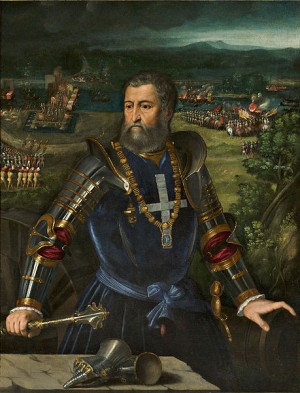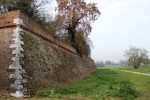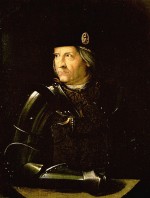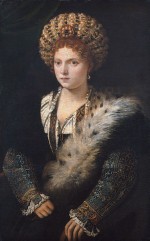Alfonso I d'Este
Ludovico Ariosto fought alongside Duke Alfonso I d’Este, whom he admired both for his expertise in the art of war, and for his generous promotion of the fine arts.
The relationship between Ariosto and Alfonso I d'Este
Among the protectors of Ariosto were, as well as Cardinal Ippolito I d’Este, his brother Duke Alfonso I d’Este. On his behalf, “Ariosto – secular cleric, fine diplomat, exquisite poet – wore the rough armour of the soldiers fighting for the House of Este” (Bertoni 1919, p. 141). These were internal clashes in the renewed war with Venice, for which the League of Cambrai (1508) saw Pope Julius II, Emperor Maximilian I, King Louis XII of France, and the King of Spain allied on an exceptional basis with Alfonso I d’Este, who wished to reconquer the Polesine area lost by his father during the 1483 war. The following verses in Orlando Furioso were dedicated to the Este victory shrewdly won by Cardinal Ippolito during the conflicts in 1509-1510:
Among the warriors of antiquity
Much gentleness and courtesy appear,
Virtues but seldom seen with us; while we
Of evil ways, on all sides, see and hear.
Hippolytus, when you, with ensignry
Won from the foe, and with his captive gear
Adorned our temples; and his galleys bore,
Laden with prey, to your paternal shore;
(Orlando Furioso, Canto 36, 2)
Ariosto offers a lively description of that battle, stating how like Alfonso he had not only been engaged in diplomatic pursuits, but also played an active part in the war effort.
I Hercules and Alexander viewed,
Urged by too sovereign ardour, side by side,
Spurring before all others in their mood,
Even within the hostile ramparts ride;
And prick so far, the second ’scaped with pain,
And on the foremost closed the opposing train.
(Orlando Furioso, Canto 36, 6)
In addition to the war with Venice to annex the territories of Rovigo and Polesine was the threat to the Duchy posed by the Papal States, which subsequently allied itself with the Most Serene Republic. The rancour of the church towards Ariosto was so implacable, that in Orlando Furioso Ariosto was unsure whether to define it as a mother or stepmother.
Well is it that his wisdom shines as bright
As his good sire’s, nor is his valour less;
Since here usurping Venice arms for fight,
And her full troops his scanty numbers press,
There she (I know not if more justly hight
Mother or stepmother) brings new distress.
(Orlando Furioso, Canto 3, 52)
The climate of hostility between Pope Julius II's Rome and Alfonso I’s Ferrara reached such a level that the Easter Sunday battle in Ravenna in 1512, known as “Bloody Easter”, was included by Ariosto in Orlando Furioso and became a famous episode. The Estes were allied with France during the battle against the armies of Spain and the Papal States, and a skilful manoeuvre performed by the Este artillery caused the enemy troops to lie prone on the ground, allowing the Este army to take advantage of the situation and trample them with their horses. Alfonso I was said to have mounted “two large, spirited steeds” who were accustomed to dispatching the enemy by kicking and jumping on them, so much so that their kill count merited a portrait being kept of them. Credit for the victory which followed was awarded entirely to the Duke, who was thus immortalised by Ariosto in his poem:
Tis he, who with his counsel and his lance,
Shall win the honours of Romagna’s plain,
And open to the chivalry of France
The victory over Julius, leagued with Spain.
Paunch-deep in human blood shall steeds advance
In that fierce strife, and struggle through the slain;
’Mid crowded fields, which scarce a grace supply,
Where Greek, Italian, Frank, and Spaniard die.
(Orlando Furioso, Canto 3, 55)
Alfonso was known for his focus on art and improving Ferrara. His administration was responsible for the creation of unique works. He is responsible for the birth of the “Camerini di Alabastro”, two private studies built above the Via Coperta, for which Alfonso engaged some of the most important artists of the era: Antonio Lombardo, Giovanni Bellini, Titian, Dosso Dossi. He also came up with the idea to decorate the bastions of the city of gardens and tree-lined boulevards, creating the green oases known as Delizie. The most magnificent of these was the Delizia del Belvedere, an arched spit of land located in the middle of a meander of the Po near the city walls. The island became a magnificent park where exotic animals of hitherto unknown species were gathered, while the architecture of the palazzo was embellished with spectacular frescoes and paintings. The wonders of this island were destroyed when Ferrara was devolved to the Papal States, but a description remains in the verses of Orlando Furioso:
Of islands this should be the fairest one
In sea, or pool, or river, far and near:
So that who this beheld, would brook no more
To hear that praised which fair Nausicaa bore.
He heard, it in fair mansions would outdo
That island which Tiberius held so dear;
And trees that in Hesperian gardens grew
Would yield to what this beauteous place should bear;
—So rare its race of beasts—no fairer shew
Herded or housed erewhile by Circe were;
Venus with Loves and Graces there should sport, Nor more in Gnide and Cyprus keep her court.
(Orlando Furioso, Canto 43, 57 -58)
Brief Biography
Alfònso I d'Este was duke of Ferrara, Modena and Reggio. He was born in Ferrara on 21 July 1476, to Ercole I and Eleanor of Naples, the first-born male after Isabella and Beatrice, who would be followed by Ferrante, Ippolito and Sigismondo. He took over as leader of Ferrara after the death of his father in 1505. In 1491 he married Anna Sforza, who however died six years later at a very young age. In 1501, thanks to skilful diplomatic negotiations by his father Ercole, he married Lucrezia Borgia, daughter of Pope Alexander VI.
His reign was marked by continuous conflicts with Venice, the Papal States, France and Spain. He also had to deal with internal disturbances in Ferrara, in particular putting down the plot hatched by his two brothers Giulio and Ferrante in 1506. A standard bearer for the Papal States, he fought against Venice alongside the League of Cambrai, winning the Polesine territory which his father Ercole had lost, but in contrast with the truce signed by Julius II in 1510 and was punished with the loss of the territories of Modena and Mirandola. Reconquering Modena and later Reggio as well was the object of the clashes and alliances which characterised the following years, where Alfonso fought to stem the expansionist designs of the Papal States towards Ferrara. He reconquered Modena and Reggio only between 1530 and 1531, thanks to years spent building strategic alliances. In particular, he strengthened relations with France with the marriage of his son Ercole to Renée of France, and he gained the support of Charles V, Holy Roman Emperor, who thanks to the Cologne award allowed him to regain the lost territories.
During the pauses in fighting, Alfonso I d’Este dedicated himself to managing and improving Ferrara, surrounding himself with artists and writers, in particular Titian, Dossi and Ariosto. The Duke’s propensity for the fine arts was something he had cultivated since his youth: “Alfonso, still young, in 1493 would pass most of his day with the founder of the Ferrarese school, Ercole Roberti, who was engaged in drawings for the Delizia di Belriguardo. Some complained about this excessive attention from the prince, but in the meantime the future Duke's artistic formation was coming about, which in joining in those manual artistic tasks, also provided him with rest from day-to-day administrative duties” (Bertoni 1919, p. 196). Amongst the most important works carried out under his direction was the construction of the previously mentioned “Delizia” on the Belvedere island (1514-1516). After the death of Lucrezia Borgia in childbirth in 1519, Alfonso entered a relationship with Laura Dianti whom, according to certain reliable sources, but without official confirmation from the church, he married before dying on 31 October 1534.
Bibliography
- Lodovico Antonio Muratori, Delle antichità estensi ed italiane: trattato, Stamperia ducale, Modena 1717-1740
- Giulio Bertoni, L’Orlando furioso e la Rinascenza a Ferrara, Cav Orlandini, Modena 1919
- Gianna Pazzi, Ferrara antica e Ferrara d'oggi (1000-1927), Lunghini & Bianchini, Firenze 1929
- Ludovico Ariosto, Cesare Segre, Orlando furioso, I Meridiani Mondadori, Milano 1976
- Antonio Panizzi, Alessandro Marcigliano, La vita di Ariosto, Atti della Deputazione Provinciale Ferrarese di Storia Patria, SATE, Ferrara 1988
- Riccardo Rimondi, Estensi. Storia e leggende, personaggi e luoghi di una dinastia millenaria, Cirelli&Zanirato, Ferrara 1999
- Luciano Chiappini, Gli Estensi. Mille anni di storia, Corbo, Ferrara 2001
Related places
Related Subjects
Compiling entity
- Assessorato alla Cultura e al Turismo, Comune di Ferrara
Author
- Stefania De Vincentis





